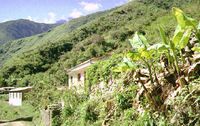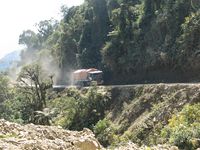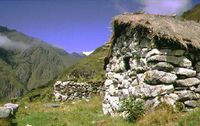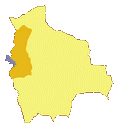The death road
 On the buttress of the Andes, to the North-East of
La Paz, the Yungas are warm, humid and green areas of medium altitude (1500-2500m).
The spectacular drive to the Yungas plunges 3000 metres in around 4.5 hours. There are two ways to reaches the valleys:
the
"death road"
On the buttress of the Andes, to the North-East of
La Paz, the Yungas are warm, humid and green areas of medium altitude (1500-2500m).
The spectacular drive to the Yungas plunges 3000 metres in around 4.5 hours. There are two ways to reaches the valleys:
the
"death road" ![]() , which well deserves its name because the stony and sinuous track appeared to be very dangerous (with frequent
landslides) in the rainy season; it is still used by some local people and tourist agencies
offering adventurers a day of downhill mountain bikes. The new asphalt road is second option to reach the Yungas: it is much
safer, and has been operational since 2007 to replace the old track.
, which well deserves its name because the stony and sinuous track appeared to be very dangerous (with frequent
landslides) in the rainy season; it is still used by some local people and tourist agencies
offering adventurers a day of downhill mountain bikes. The new asphalt road is second option to reach the Yungas: it is much
safer, and has been operational since 2007 to replace the old track.

Many minibus companies provide connections with the principal villages of the Yungas; the alternative for the more adventurous or economical traveler is a journey by truck (not in the cab but in the fresh air at the back!). The bus terminal servicing the Yungas valleys (Coroico, Chulumani, Coripata, Guanay...) is located on the avenida de las Americas in Villa Fatima (La Paz).
The fertile Yungas are a major contributor to the Bolivian economy, supplying fruit and vegetables to the regions of the altiplano, and in particular to the capital. Trucks loaded with tons of fruit, vegetables, coffee, coca and rubber drive daily to the markets of La Paz.
 While the Yungas may look like a wild paradise to some people,
the descent from the altiplano will test even the strongest nerves! Anyone considering driving down to the Yungas via the old road
in the rainy season is strongly advised to think again. On average, before the construction of the new road, there used to be at
least one accident per week (~400 deaths/year), with few surviving a near vertical plunge into the ravine far below.
In the Yungas, everybody drives on the left hand side, in contrast to the rest of the country. This is to enable the driver to keep
an eye on the wheel closest to the precipice, especially passing other vehicles along the very narrow road.
While the Yungas may look like a wild paradise to some people,
the descent from the altiplano will test even the strongest nerves! Anyone considering driving down to the Yungas via the old road
in the rainy season is strongly advised to think again. On average, before the construction of the new road, there used to be at
least one accident per week (~400 deaths/year), with few surviving a near vertical plunge into the ravine far below.
In the Yungas, everybody drives on the left hand side, in contrast to the rest of the country. This is to enable the driver to keep
an eye on the wheel closest to the precipice, especially passing other vehicles along the very narrow road.
Adventurous types may also decide to return to La Paz seated on a pile of coffee or banana sacks in the back of a truck. If you do,
be prepared to leave the valley in your Tee-shirt and pass the Cumbre (saddle at an altitude of about 5000 meters) in a warm pullover
and anorak (possibly even a wool blanket if your neighbour does not mind sharing it!). You will arrive at Paz tired after long hours
of driving (an overloaded truck moves surprisingly slowly) and covered with dust, but you will certainly never forget the experience.
Coroico
Half way between the Andes and the Amazon, the town of
Coroico ![]() (Northern Yungas) is a very popular destination for the citizens
of La Paz during weekends and festivals. Located at 1800m above sea level, the small town of 3500 inhabitants offers peace and tranquility
in a semi-tropical atmosphere. What could be more pleasant than sipping a freshly pressed papaw juice, lying at the poolside in the shade
of a banana tree? Dreams are made of this...
(Northern Yungas) is a very popular destination for the citizens
of La Paz during weekends and festivals. Located at 1800m above sea level, the small town of 3500 inhabitants offers peace and tranquility
in a semi-tropical atmosphere. What could be more pleasant than sipping a freshly pressed papaw juice, lying at the poolside in the shade
of a banana tree? Dreams are made of this...

Coroico is also...
- Walks among fields of coca or in the orange groves,
- A trek to the 3
waterfalls
 ,
7km away from Coroico (one can rent a taxi to quickly get there),
,
7km away from Coroico (one can rent a taxi to quickly get there),  Discovery of
tropical flora and fauna
Discovery of
tropical flora and fauna  ,
,- Swimming at the so called
"Pozas del Vagante"
 ,
in the river 600m downwards from Coroico
(8 km by road, 8h walk). Be careful, the return walk may be quite difficult, especially under a blazing sun!. The less sporty
may prefer to organize their transport from Coroico to the river in order to really enjoy the relaxing picnic & swimming place),
,
in the river 600m downwards from Coroico
(8 km by road, 8h walk). Be careful, the return walk may be quite difficult, especially under a blazing sun!. The less sporty
may prefer to organize their transport from Coroico to the river in order to really enjoy the relaxing picnic & swimming place), - Walking up to the chapel dominating the city and commanding a spectacular view over the valley and the snowy Huayna Potosí and Mururata peaks (when the weather is good).
Advice: In the Yungas, nobody should forget the insect repellant and soothing cream! The small tropical flies
(nasty yellow flies according to the "Lonely planet" handbook) are extremely aggressive with particularly deep and painful bites.
Watch out during your excursions on the rocky Yungas trails, one can encounter rattlesnakes in the hills near Coroico (Mount Uchumachi).
Vallée de Zongo
 The
Zongo valley
The
Zongo valley ![]() starts at the foot of Huayna Potosi (mountain pass at an altitude of 4700m) and ends at the village of Huaji. The road descending
to the valley is as spectacular as the one that reaches the Yungas, but far less perilous. Indeed, the track is very well maintained by an
electricity company that operates the ten hydroelectric stations distributed over 3000m of uneven terrain in the area.
starts at the foot of Huayna Potosi (mountain pass at an altitude of 4700m) and ends at the village of Huaji. The road descending
to the valley is as spectacular as the one that reaches the Yungas, but far less perilous. Indeed, the track is very well maintained by an
electricity company that operates the ten hydroelectric stations distributed over 3000m of uneven terrain in the area.
 During the descent into the valley, the arid and austere landscapes of puna and stone drains is
progressively replaced by tropical vegetation. Along the way, one should observe the typical small dwellings of the area, built of stone and
with straw roofs. The many power stations and the large artificial cascades that they generate are an attraction in the valley. Zongo valley
is a popular starting point for mountain trekkers.
During the descent into the valley, the arid and austere landscapes of puna and stone drains is
progressively replaced by tropical vegetation. Along the way, one should observe the typical small dwellings of the area, built of stone and
with straw roofs. The many power stations and the large artificial cascades that they generate are an attraction in the valley. Zongo valley
is a popular starting point for mountain trekkers.
You should complete your tour of the Zongo valley in one day (there are no restaurants or accommodation in the valley).
Taquesi trekking
The Taquesi trek is an Inca road extending approximately 50km, which was used for the exchanges of produce and other commodities between the altiplano and the Yungas valleys. In some places, the pre-Hispanic paving stones still appear in a perfectly preserved state. The roads were built according to strict rules of construction (4m wide, paved, with staircases, buttress walls and irrigation trenches), which made them remarkably resistant to the passage of five centuries. The starting point of the Taquesi trek is the village of Ventilla - at around 3600m above sea level and 35km from La Paz. The excursion can be completed in two days, starting with the climb to a mountain pass at 4600m before going down to the mining village of Chojlla at 2200m (and a possible connection to other cities of the Yungas by bus). Breathtaking landscapes await adventurous and determined hikers - this is not a trip for the faint-hearted (or those with weak knees)!





